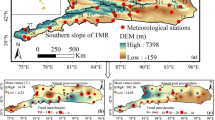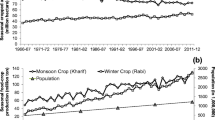Abstract
Extreme temperatures around flowering of wheat have the potential to reduce grain yield and at farm scale their impact can be spatially variable depending on topography. Twenty-five data loggers were installed at 0.8-m height across a 164-ha farm in the southern Mallee of Victoria, Australia to spatially record the daily course of temperatures around the average date of flowering of wheat in the region. The experiment was conducted during 2-years period. In 1 year, the farm had no crop cover and in another year the farm had a wheat crop. Multiple linear regression analysis techniques were used to fit models relating daily extreme temperatures to the farm topographic features of elevation, aspect and slope, and the average maximum and minimum temperatures of each day at the farm in order to identify areas of high risk of extreme temperatures around the time of the flowering of wheat. The fitted regression models explained 90% and 97% of the variability in maximum and minimum temperatures, respectively, when the farm had no crop cover and 80% and 94% of the variability in maximum and minimum temperatures, respectively, when the farm had a wheat crop cover. When the farm had no crop, only minimum temperature was partially explained by the topography however, both maximum and minimum temperatures were partially explained by the topography when the farm had a wheat crop. From this study it was concluded that, (1) high temperature variations were found across the farm (2) temperature variations were only partially explained from the developed model presumably due to the flatter topography of the farm and (3) the relationships obtained from this study could be used in a crop model which can explain variation in grain yield based on the topography of a field.






Similar content being viewed by others
References
Abuzar M, Rampant P, Fisher P (2004) Measuring spatial variability of crops and soils at sub-farm scale using Remote Sensing technologies. In: Proceedings of IEEE International Geoscience and Remote Sensing Symposium (IGARSS2004), Anchorage, Alaska, 20–24 Sept 2004, vol 3. IEEE, Piscataway, pp 1633–1636
Armstrong RD, Fitzpatrick J, Rab MA, Abuzar M, Fisher PD, O’Leary G (2009) Advances in precision agriculture in south-eastern Australia. III. Interactions between soil properties and water use help explain spatial variability of crop production in the Victorian Mallee. Crop & Pasture Sci 60:870–884
Asana RD, Williams RF (1965) The effect of temperature stress on grain development in wheat. Aust J Agric Res 16:1–13
Banath CL, Single WV (1976) Frost injury to wheat stems and grain production. Aust J Agric Res 27:749–753
Barringer JRF (1997) Meso-scale mapping of soil temperatures in the Mackenzie Basin, New Zealand. Proc GeoComp 1997 and SIRC 1997. University of Otago, New Zealand, 26–29 August 1997
Barry RG (1992) Mountain weather and climate. Routledge, London, p 402
Bougeault P, Bret B, Lacarrene P, Noilhan J (1991) An example of spatial integration of a land-surface parameterization in a Meso-Beta scale model. In: Schmugge TJ, Andre JC (eds) Land surface evaporation: measurement and parameterization, Chapter 24. Springer, New York
Cawood R (1996) Thermal environment. In: Cawood R (ed) Climate, temperature and crop production in south-eastern Australia. (Principles of Sustainable Agriculture, 7. Agriculture Victoria, Horsham, Victoria, pp 109–118
Cawood R, McDonald G (1996) Climate of South Eastern Australia. In: Cawood R (ed) Climate, temperature and crop production in south-eastern Australia. (Principles of Sustainable Agriculture, 7. Agriculture Victoria, Horsham, Victoria, pp 21–33
Dixit PN, Chen D (2010) Farm scale zoning of extreme temperatures in the southern Mallee, Victoria, Australia. Biosyst Engg 105:198–204
Dy G, Payette S (2007) Frost hollows of the boreal forest as extreme environments for black spruce tree growth. Can J Forest Res 37:492–504
ESRI (1996) ArcView GIS: the Geographic Information System for everyone. ESRI, Redlands, CA, USA, pp 340
ESRI (2001) Using ArcGIS Spatial Analyst. ESRI, Redlands, CA, USA, pp 230
Fischer RA (1979) Growth and water limitation to dryland wheat yield in Australia, a physiological framework. J Aust Inst Agric Sci 45:83–94
Fisher PD, Abuzar M, Rab MA, Best F, Chandra S (2009) Advances in precision agriculture in south-eastern Australia. I. A regression methodology to simulate spatial variation in cereal yields using farmers’ historical farm yields and normalised difference vegetation index. Crop & Pasture Sci 60:844–858
Fitzpatrick EA, Laughlin GP (1981) Topographic and climatic controls of frost hazard in the Goulburn District. In: Report prepared for CSIRO Institute of Earth Resources, Division of Land Use Research, Canberra, p 119
Ghuman BS, Lal R (1983) Effect of crop cover on temperature regime of an alfisol in the tropics. Agron J 75:931–936
Gonzalez-Dugo MP, Neale CMU, Mateos L, Kustas WP, Prueger JH, Anderson MC, Li F (2009) A comparison of operational remote sensing-based models for estimating crop evapotranspiration. Agric Forest Meteor 149:1843–1853
Grace J (1988) Temperature as a determinant of plant productivity. In: Long SP, Woodward FI (eds) Plants and temperature. The Company of Biologists, Cambridge, pp 91–107
Hocevar A, Martsolf JD (1971) Temperature distribution under radiation frost conditions in a central Pennsylvania valley. Agric Meteor 8:371–383
Isbell RF (1996) The Australian soil classification, vol. 4. CSIRO, Melbourne, p 143
Kalma JD (1984) Theory and practice of measuring and estimating air temperature in local climate studies. Proceeding of United Nations University Workshop on Need for Climatic and Hydrologic Data in Agriculture in South East Asia, Canberra, December 1983. Fitzpatrick EA (ed), pp 105–116
Kalma JD, Laughlin GP, Green AA, O’Brien MT (1986) Minimum temperature surveys based on near-surface air-temperature measurements and airborne thermal scanner data. J Climatol 6:413–430
Kalma JD, Alksnis H, Laughlin GP (1988) Calibration of small infra-red surface temperature transducers. Agric Forest Meteor 43(1):83–98
Kawashima S, Ishida T (1992) Effects of regional temperature, wind speed and soil wetness on spatial structure of surface air temperature. Theor Appl Climatol 46:153–161
Kelleher FM, Rollings NM, Poulton DM, Cornish PS (2001) Temperature variation and frost risk in undulating cropland. In Proc of the 10th Aust Agron Conf, 2001. Hobart. Australia
Laughlin GP, Kalma JD (1987) Frost hazard assessment from local weather and terrain data. Agric Forest Meteor 40:1–16
Lindkvist L, Lindqvist S (1997) Spatial and temporal variability of nocturnal summer frost in elevated complex terrain. Agric Forest Meteor 87(2–3):139–153
Lookingbill TR, Urban DL (2003) Spatial estimation of air temperature differences for landscape-scale studies in montane environments. Agric Forest Meteor 114:141–151
Maes B, Trethowan RM, Reynolds MP, van Ginkel M, Skovmand B (2001) The influence of glume pubescence on spikelet temperature of wheat under freezing conditions. Aust J Plant Physiol 28:141–148
Martin P (2002) Frost—Has anything changed? Farmer Research Update—Southern Region—2002. Wagga Wagga, NSW Agriculture
Marcellos H, Single WV (1975) Temperatures in wheat during radiation frost. Aust J Exp Agric Animal Husb 15(77):818–822
McCutchan MH, Fox DG (1986) Effect of elevation and aspect on wind, temperature and humidity. J Climate Appl Meteor 25:1996–2013
Ookouchi Y, Segal M, Pielke RA, Mahrer Y (1987) On the effect of soil wetness on thermal stress. Int J Biometeor 31:45–55
Phillips DL, Dolph J, Marks D (1992) A comparison of geostatistical procedures for spatial analysis of precipitation in mountainous terrain. Agric Forest Meteor 58:119–141
Porter JR, Gawith M (1999) Temperatures and the growth and development of wheat: a review. Eur J Agron 10(1):23–36
Potgieter AB, Hammer GL, Butler D (2002) Spatial and temporal patterns in Australian wheat yield and their relationship with ENSO. Aust J Agric Res 53:77–89
Rab MA, Fisher PD, Armstrong RD, O’Leary G, Anwar MR, Reilly C, Abuzar M, Fitzpatrick J (2006) Managing spatial variability of grain yield at the farm level in south-eastern Australia. In ‘Australian Agronomy Conference’. 6–14 Sept. 2006, Perth, WA
Rab MA, Fisher PD, Armstrong RD, Abuzar M, Robinson NJ, Chandra S (2009) Advances in precision agriculture in south-eastern Australia. IV. Spatial variability in plant-available water capacity of soil and its relationship with yield in site-specific management zones. Crop & Pasture Sci 60:885–900
Rampant P, Abuzar M (2004) Geophysical tools and digital elevation models: tools for understanding crop yield and soil variability. In ‘Supersoil 2004. 3 rd Australian New Zealand Soils Conference’. 5–9 December. 2004, University of Sydney, Australia
Russell G, Wilson GW (1994) An agri-pedo-climatological knowledge base of wheat in Eur Joint Res Centre, EU, Luxembourg, 158 pp
Single WV (1961) Studies on frost injury to wheat I. Laboratory freezing tests in relation to the behaviour of varieties in the field. Aust J Agric Res 12:767–782
Slafer GA, Slavin R (1991) Developmental base temperature in different phenological phases of wheat (Triticum aestivum). J Exp Bot 42:1077–1082
Tveito OE (2002) Spatial distribution of winter temperatures in Norway related to topography and large-scale atmospheric circulation, PUB Kick off meeting, Brasilia, Brazil 20–22. November 2002, 1–8
Wheeler TR, Batts GR, Ellis RH, Hadley P, Morison JIL (1996) Growth and yield of winter wheat (Triticum aestivum L.) crops in response to CO2 and temperature. J Agric Sci Camb 127:37–48
Wheeler TR, Craufurd PQ, Ellis RH, Porter JR, Prasad PVV (2000) Temperature variability and the yield of annual crops. Agric Ecosyst Envir 82:159–167
Acknowledgment
The financial support provided by the University of Melbourne in the form of Melbourne International Fee Remission Scholarship and Melbourne International Research Scholarship is greatly acknowledged. The help extended by the Department of Primary Industries (DPI), Horsham and Birchip Cropping Group is duly acknowledged. The authors are grateful to Dr. Daniel Rodriguez, DPI-Queensland and Dr. John Angus, CSIRO - Canberra for providing constructive suggestions.
Author information
Authors and Affiliations
Corresponding author
Rights and permissions
About this article
Cite this article
Dixit, P.N., Chen, D. Effect of topography on farm-scale spatial variation in extreme temperatures in the Southern Mallee of Victoria, Australia. Theor Appl Climatol 103, 533–542 (2011). https://doi.org/10.1007/s00704-010-0327-2
Received:
Accepted:
Published:
Issue Date:
DOI: https://doi.org/10.1007/s00704-010-0327-2




